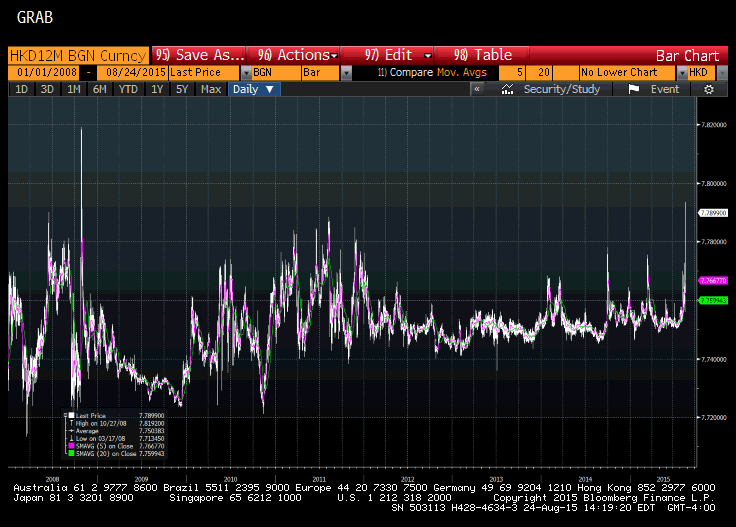There are two currency pegs that serve as bedrocks. They were not tackled in the series of emerging market crisis that began in the mid-1990s. They did not succumb during the Great Financial crisis. Yet the market is betting that they fall.
The two pegs are the Honk Kong dollar and Saudi Arabia's riyal. You can't see the pressure looking at the spot market. They are pegged, after all. Rather you can see wagers in the forward market. 
Here are the Great Graphics, from Bloomberg, charting the 12-month forward points for the Saudi riyal and the Hong Kong dollar. The charts begin in early 2008 so one can appreciate the significance of what is happening now. Some are positioning to benefit if Saudi Arabia weakens its currency in the face of new declines in oil prices and a draw down in reserves.
The pressure in the Saudi 12-month forward encountered mild upside pressure in July, but it has intensified over the last couple of weeks. Recall that as Asia's largest oil exporter, Kazakhstan had tried to maintain a pegged currency regime until deciding to let its tenge float last week. It warned that other oil producers face the same choice. 
The pressure on the Hong Kong dollar forwards is new. The forward points held fairly steady as Chinese stocks sold off hard in July. They turned more volatile since China devalued the yuan, but soared yesterday after the Hang Seng fell 5.2% and the Shanghai Composite fell 8.5%. The 12-month forward points for the Hong Kong dollar are the highest since Lehman failed.
We suspect that monetary authorities in Riyadh, Hong Kong, and Beijing are loath to be pushed into a policy change by market participants. In 1997, Hong Kong launched a strong and successful defense of its peg. Saudi Arabia has frustrated leveraged players who from time-to-time have thought the riyal was vulnerable. The key judgment call is whether there is the political will to do it again. We think so.
For market participants, however, the forward points may be used as a non-equity market gauge of the fear factor. It is telling us the same thing that the S&P 500 is when it is four standard deviations from its 20-day moving average. The market move is excessive, but technical indicators have not signaled that the excess is over.
